D-Rings & Fasteners
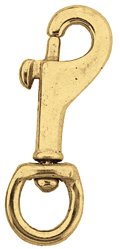
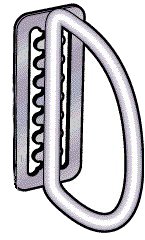
Diving in the North Atlantic requires a lot more accessory gear than diving in the tropics. This can include knife, spare knife, light, spare light, marker light, flag & line, slate, dive tables, goody bag, spear, spear gun, tickle stick, reel, lobster gauge, lift bags, camera and lights, hammer, and a whole lot more if you are into heavy-duty wrecking, although hopefully not all of it at the same time.
Except for the new pseudo-technical BCs, most BCs just don't have enough D-rings. One solution is to add a few stainless steel D-rings to your weight belt or harness. You can get these ready-made from your dive shop for a few dollars. The best kind are those that are welded onto a slide-buckle so that they stand out rigidly away from your body. D-rings that are not fixed like this will inevitably fold under, making them impossible to use ( or even find ) with thick gloves on. Remember, once you are in the water with your mask on, most of yourself will be out of sight, and you will have to work everything by touch.
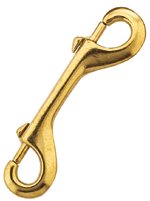
To connect to your D-rings, get some brass thumb snaps. Get the biggest ones available in solid brass only ( or stainless steel, but that is very expensive and not necessary. ) Hardware stores used to sell solid brass snaps at hardware prices, but I have not seen one in a long time, nowadays it is all brass-plated junk, not suitable for diving. The best is the kind shown above, which can be operated with just one hand. Double-ended snaps are sometimes also useful, as are small trigger snaps (below) I like to use trigger snaps for items that I would not normally want to release. Even with gloves on, you can easily feel the difference between a regular snap and a trigger snap, and that tells you that you have the wrong thing in your hand. Carabiners and swivel-eyes ( also known as "suicide clips" ) should be avoided, as both are prone to entanglement and self-release.
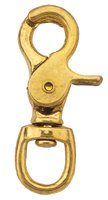
Attach a brass snap to every item you carry with a bit of nylon line or a wire tie, and then you can decorate yourself like a Christmas tree. By putting the snaps on all your accessories, and the loops on yourself, you achieve the maximum in configuration flexibility - you can attach anything anywhere, and switch things around as you like. Also, should an accessory or a snap itself become entangled, it is an easy matter to release it.
One thing about wire ties - they are held together by a tiny plastic pawl inside the buckle, which is a lot weaker than the rest of the apparatus and will break under strain. Some also have metal pawls which will rust over time. For heavy-duty applications, tie things together securely with a shoelace or a scrap of wreck reel line. Wire ties are really only good for light-duty temporary use.
Surgical tubing is useful for all kinds of things. One thing you can do with it is make a loose-fitting loop for your neck, and attach it to your main regulator. This will keep it up where you can always find it, and out of harm's way when entering or exiting, especially on shore dives. Just be sure that the regulator can come free from the loop in an emergency, or your buddy might tear your head off one day. The necklace configuration can also save your second stage from being crushed under your tank ( or someone else's ) when you sit down! You can get lightweight surgical tubing in a rainbow of colors at your local fishing tackle shop. Lightweight bungee cord is an alternative to surgical tubing for many applications.
As for octopus retainers, I have not run across any design that actually works. An inadvertent tug and your spare second stage will be trailing in the mud, hard to find, and probably unusable. This pretty much defeats its entire purpose. Instead, I tie a trigger snap to mine, and clip it off to a chest D-ring ( right-side, to avoid cross-chest entanglements should I want to get out of my BC. ) Sure, it's not going to break away easily like you were taught it should, but in real life, an out-of-air diver in a panic is going to snatch your primary right out of your mouth, so that's not really an issue. At that point, you can calmly unclip your spare, and start using it yourself, and it won't be full of sand and mud. Another option is to attach both second stages to your 'necklace' as described above. This configuration is especially good when diving independent doubles, as it keeps both regs readily available.
Finally, try to make sensible use of your BC pockets. You can use pieces of shoelace to make lanyards for keys, etc, and tie them on inside the pocket. This way things won't get lost even if you accidentally knock them out.
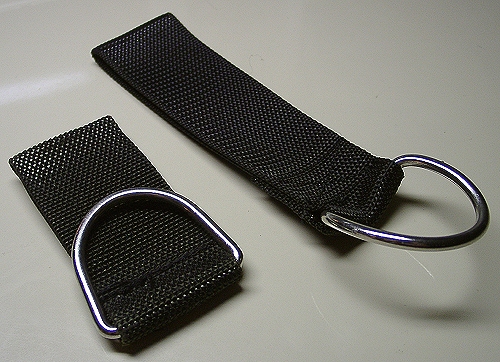
Above are a pair of weight belt-style D-rings. These are great because you can place them just about anywhere. The one on the left shows the major disadvantage of these things, though - the ring flips up ( and usually under ) in use, making it in practice nearly impossible to locate or use. The one on the right shows a simple solution to this problem: a 90-degree bend in the base of the ring prevents it from rotating in the stiff nylon web. Not only is the D-ring held rigidly straight, the bend also acts as a stand-off, holding the ring away from your body, and making it even easier to find. The best way to bend a D-ring like this without distorting it is to clamp the base of it halfway in a vise, nylon and all, and bang it over with a hammer.
DIR
DIR permits a grand total of five D-rings, in specific locations. This artificial limitation is totally unnecessary, and in fact downright stupid. Bolt snaps are as described above, except stainless steel is encouraged over brass because you can cut yourself on brass ( but not stainless steel? I'm scratching my head over that one. )
One good idea from DIR is that every attached accessory should have a cut-able link. Snap fasteners like these do jam up with sand and grit from time to time. If an accessory should become entangled, you should be able to cut it away if the fastener jams. Tying things together with wreck line as described above satisfies this requirement.
